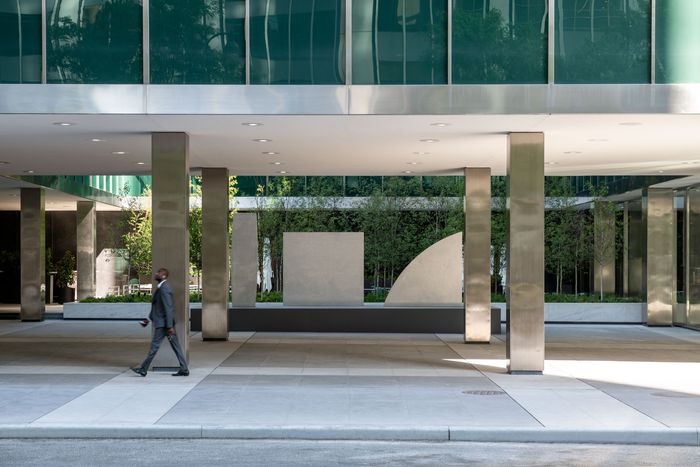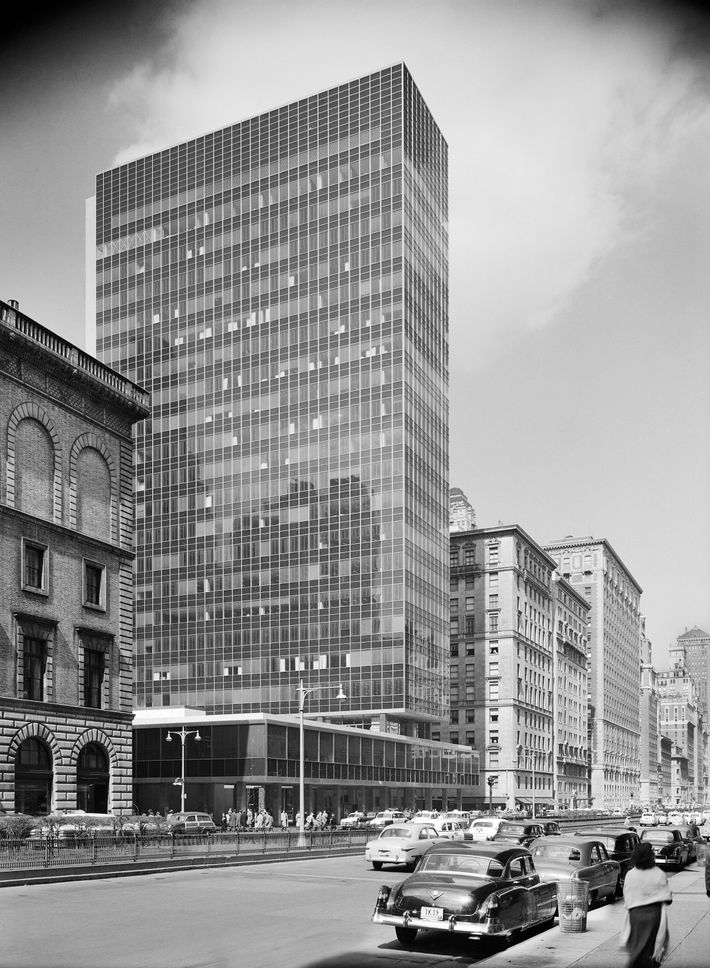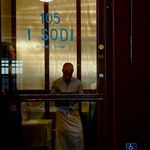
If you were looking for modern Manhattan glamour in 1932, you might have checked into the Waldorf-Astoria Hotel, the Park Avenue magnet for those who could still afford to glitter. Its black-tie parties, grand stairways, verdant lobbies, and high-ceilinged ballroom — Machine Age replacements for their fussy Victorian predecessors on 34th Street — were made even more lustrous by the everyday glumness of the Depression. The hotel’s exuberance projected confidence that this darkness, too, would pass. If you were searching for the more muted daytime elegance prominent 20 years later, you might have tried to wangle a meeting at the Lever Brothers headquarters three blocks uptown, where white men in dark suits strategized about selling toothpaste and soap. “We wish the company prosperity and progress in its bright new home,” the Times burbled when Lever House opened in 1952. The tower seemed made of sunlight and optimism; it had a fresh, minty sheen.
Time, neglect, and expediency did a number on both structures. At Lever House, the plaza pavers were pitted and smashed, travertine was streaked, glass walls had clouded, and steel panels looked like they’d been used for slingshot practice. At the Waldorf Astoria (its hyphen excised in 2009), the light-brick-and-limestone façade had darkened from pale gray to fuliginous, and the Art Deco interiors had acquired encrustations of yellowed varnish and tacky décor. Ornamental metal panels had been punched out to make room for air-conditioning units.
Fortunately, the job of figuring out how to bring both landmarks back to their glory days has gone to Frank Mahan, a principal at the architecture firm Skidmore, Owings & Merrill, and his approach to historic preservation is both sweepingly philosophical and obsessively detailed. The two projects vary in style, process, and scope, and they’re on different timelines: SOM’s $1 billion renovation of the Waldorf Astoria (for Dajia US) is still a couple of years away from completion. Lever House’s makeover, by SOM and Brookfield (along with WatermanCLARK) at one-tenth the price, is almost done. The hotel is losing two-thirds of its 1,400 rooms and gaining 375 condos. The office building, once entirely occupied by Lever, will now get a different tenant on each of its 24 floors and a tenants-only club atop its low-rise podium. But both are high-rise bookends to a short compendium of distinguished Park Avenue midtown architecture: St. Bartholomew’s Church, McKim, Mead & White’s New York Racquet Club, and the Seagram Building, with a newcomer, Foster and Partners’ 425 Park Avenue, just up the street. And even though some New Yorkers may remember a time before either of them existed, they are antique enough by the city’s standards to require a quasi-archeological approach. Mahan captains a meticulous army of artisans, lab technicians, engineers, restorers, stone experts, metalworkers, and contractors, who have been fussing over both buildings with tweezers and loupes. Taken together, the two renovations bode well for the future of the past.
We’ll have to wait a while for the bandages to come off the Waldorf Astoria, though I’m optimistic. At Lever House, the results of the rejuvenation are in, and they’re dazzling. The terrazzo floors glide from inside to out, and so does the white-marble planter that slips through a glass wall like a ghost to hold a grove of young birches. In the lobby, steel-ribbed glass boxes like miniature modern houses once displayed Lever Brothers products like saintly relics; now they hold Ellsworth Kelly sculptural models on loan from MoMA.
The mission for the SOM-led team was to scroll back to opening day, April 29, 1952 — or, rather, to what the building would have looked like that morning if it had been fitted out with LED bulbs, automated lighting controls, and ventilation systems that lay 70 years in the future. Designed by Gordon Bunshaft and Natalie de Blois, the prophets of SOM’s International Style aesthetic, Lever House was the first office tower in America with glass curtain walls on all four sides. (The earlier UN Secretariat Building has two, sandwiched between stone ends.) Even at night, the tower was a photographer’s dream, the floor slabs drawing black stripes across a vertical bar of light. I’m not convinced by every upgrade. In early photos, the podium appears to levitate over a cushion of shadow; the newly installed more powerful lighting has dispelled the darkness under the canopy, making it glow right down to street level, day and night. What Mahan sees as a limitation of mid-century lighting and has “rectified” looks to me like it was a deliberate chiaroscuro effect, but even with all the documentation that SOM’s architects bequeathed to their successors, it’s not always easy to separate intention from execution.
Preservation is no place for purists. A working building isn’t a Revolutionary War reenactment; historical accuracy can be counterproductive, as the Landmarks Preservation Commission acknowledges. The commission objected to interrupting the black limestone wall with a pair of added openings from the restaurant onto the plaza, so they compromised on one, tucked close to the existing revolving door. “Our approach is based in deep research into the original design intent, original built conditions, and history of change over time,” Mahan told me. Those three things are sometimes at odds. Architects design features that never get realized. Innovative buildings, almost by definition, include elements that don’t work as advertised. And successive “improvements” often nudge a design further and further from its original state. Keeping a historic building humming along means shifting constantly among the idea, the physical realization, and the need to keep adapting. Decades of use and abuse get offset with the latest technology, often disguised in retro packaging. Each style generates its own approach: Cracked stones can be salvaged, cracked glass can’t. The simpler the style, the harder — and more expensive — it is to hide the cheats. An earlier generation of SOM architects stripped away Lever House’s façade entirely in 2000 and installed a state-of-the-art double-paned curtain wall, so a (then) half-century-old landmark was wrapped in a full-scale replica of itself. Two decades later, condensation had snuck into the gaps between those glass panels. The SOM team designed a way to circulate filaments of dry air into that space and clear up the moisture. When the old materials failed, they were swapped out; when the new materials failed, they were made to breathe.
The team working on Lever House is proudly obsessive, mixing artistry and detective work. To replace broken slabs of black limestone, they tracked down the now-shuttered original quarry, which turned out to be a tiny island in the middle of Lake Champlain. They excavated slender rails between blocks of marble by chemically dissolving strips of ghastly sealant. The dented steel panels that wrap each column in the lobby had to be pried off, beaten smooth, and refinished by specialty metalworkers in Queens. Some techniques have evolved more quickly than terminology; a “high hone” today is far, far shinier than it was 70 years ago, and so the designers consulted vintage photos to gauge just how satiny the steel should be.
Today’s Lever House is a bracing illusion, a gorgeously appointed set. You know those too-perfect period movies in which everyone seems to have bought a car in the same model year and washes it constantly, and even minor characters all dress in that week’s fashions? Lever House has been refinished with a similarly deceptive attention to detail. When it opened, all that sharp-edged transparency looked radical, fleet, and European, as if a Porsche 356 had pumped itself up to building size. With the Seagram Building still several years away, the rest of Park Avenue was covered in rock and clay and now suddenly looked ancient and heavy. That bracing contrast is out of reach now after decades of Lever House knockoffs that turned skylines all over the world into the urban equivalent of a surgical tool tray: standardized, shiny, and cold. And yet, step into the lobby or the plaza enclosure, where blue-green glass and yellow-green foliage form a glimmering arbor, and you can feel, at least for a moment, that you’re in the Eden of modernism, that America faces a bright and sanitary future, and that the sins of the past could be corrected by the judicious application of detergent.






